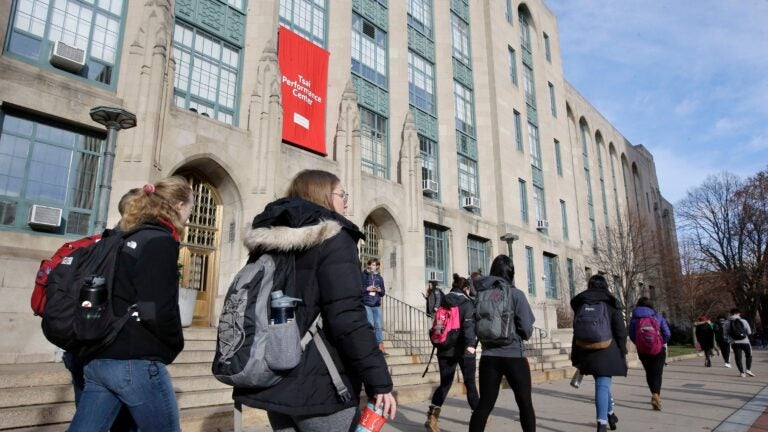Address newsletter
Get the latest news on buying, selling, renting, home design, and more.

College students in Greater Boston who forgo the dorms to rent an apartment off-campus are paying more than many of their peers around the country, a study suggests.
Three of the region’s largest and most prestigious institutions — Boston University, Harvard University, and Northeastern University — rank among the nation’s top 10 most expensive schools for off-campus housing, according to a May 29 analysis by RentHop, an apartment listing website.
With a median local monthly rent of $3,600, Boston University came in at No. 6 nationally, followed by Harvard at $3,560 per month at No. 7. The study ranked Northeastern at No. 8, citing a median monthly rent of $3,400.
“Off-campus housing remains high along the East and West coasts, with Massachusetts schools earning three spots on the most expensive list,” RentHop wrote. “With two Boston, MA campuses and Harvard University in the mix, students along the coasts can expect higher rental costs compared to schools in the Midwest and South.”
Another Massachusetts school, the University of Massachusetts Amherst, ranked No. 49, with a median rent of $1,700 per month.
The top three most expensive schools are New York University, with a median monthly rent of $4,795; the University of California Irvine, at $4,100; and New York City’s Columbia University, at $3,995 a month, the report says.
The high cost of off-campus housing around Greater Boston is hardly limited to BU, Harvard, and Northeastern students, however. There are dozens of colleges and universities in the Boston metro area, which is also home to one of the country’s most expensive and competitive rental markets.
According to a RentHop spokesperson, the schools selected for the study are simply the “100 largest colleges in the United States.”
Median rents were determined through an analysis of rental data from “over one million active off-campus rental listings located near U.S. college campuses over the three months prior to publication,” the report says. Listings considered were all within 2 miles of the center of each campus, with that radius reduced “in denser and more developed cities … to reflect housing availability around the campus,” the study says.
The cost of off-campus housing increased over the past year for 80 out of the 100 schools ranked, according to RentHop.
“Nationwide, rental market conditions limit supply and continue to drive up costs, forcing students to compete amongst themselves for housing opportunities,” the study said. “Students along the coast still cannot afford the cost of a median one-bedroom apartment on their own and must seek financial assistance from their family, acquire more debt, or rent with roommates to secure off-campus housing.”
Of the 159,720 undergraduate and graduate students who attended schools based in Boston in the fall of 2022, more than 66,000 — or about 41 percent — lived in off-campus housing around the region, according to an annual report from the City of Boston released that year, the most recent available.
Those students, who often live with classmates and friends to split costs and save money, also gravitate toward certain neighborhoods, creating demand that also contributes to high rents.
For example, Allston-Brighton, Fenway, and Mission Hill were home to 65 percent of the city’s undergraduates in 2022, according to city officials. These high concentrations place “significant pressure on the rental market of these neighborhoods,” the report from City Hall said.
Notably, BU and Northeastern, two schools with some of the city’s largest full-time undergraduate student populations, housed 65.5 percent and 47.9 percent of their respective undergrad student bodies on campus in 2022, the report said.
Yet, those two schools also had some of the highest numbers of undergraduate students living in private housing off-campus, too.
City officials wrote that the number of students living off-campus has remained “relatively stable” in recent years, despite Boston’s efforts to spur the construction of more on-campus student housing to help free up the rental market.
“Colleges and universities added 6,466 dorm beds from 2014 to 2022,” the report said. “However, only 2,872 net new beds are currently in the pipeline.”
Schools are still eying new dormitories, though.
In October 2022, Boston University unveiled a $1 billion master plan outlining potential new development over the next decade, including a possible third “Student Village,” a complex that would house 523 students, filings say.
In March, the Boston Planning & Development Agency approved a 23-story dormitory tower on the university’s campus with 1,370 beds at 840 Columbus Ave. “With a focus on community engagement and student housing, this building will fulfill Northeastern’s promise to reduce the impact of student housing on nearby neighborhoods,” John Tobin, vice president for City and Community Engagement at Northeastern, said in a statement earlier this year, per Northeastern Global News.
Get the latest news on buying, selling, renting, home design, and more.
Stay up to date with everything Boston. Receive the latest news and breaking updates, straight from our newsroom to your inbox.
Conversation
This discussion has ended. Please join elsewhere on Boston.com